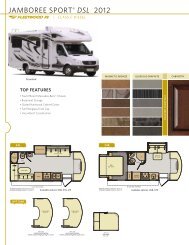You also want an ePaper? Increase the reach of your titles
YUMPU automatically turns print PDFs into web optimized ePapers that Google loves.
Living With Your Motor Home<br />
temperatures between 40ºF and 100ºF . Most<br />
importantly, mold growth requires moisture, and<br />
moisture is the only growth factor that can be<br />
controlled . By minimizing interior sources of<br />
moisture, an <strong>RV</strong> owner can reduce or prevent<br />
mold growth . However, if optimal growth conditions<br />
persist, mold can develop within 24 to<br />
48 hours .<br />
Moisture in the <strong>RV</strong> can stem from a variety of<br />
sources such as spills, leaks, overflows, condensation,<br />
damp or standing water and human<br />
activity such as showering or cooking . Good<br />
maintenance practices are essential in the effort<br />
to prevent or reduce mold growth .<br />
What the <strong>RV</strong> Owner Can Do<br />
The <strong>RV</strong> owner can take positive steps to reduce<br />
the occurrence of mold growth in the <strong>RV</strong> and<br />
thereby minimize any possible adverse effects<br />
that may be caused by mold .<br />
These steps may include, but are not limited to,<br />
the following:<br />
• Before bringing items into the <strong>RV</strong> check<br />
for signs of mold . Potted plants (root and<br />
soil), furnishings, or stored clothing and<br />
bedding materials may also contain mold<br />
spores .<br />
• Regular vacuuming and cleaning will<br />
help reduce levels of settled mold spores .<br />
Additionally, detergent solutions and most<br />
tile cleaners are effective in controlling<br />
mold growth on surfaces .<br />
• Keep the humidity in the <strong>RV</strong> below 40%.<br />
Ventilate kitchens and bathrooms by opening<br />
windows, using exhaust fans, or running<br />
the air conditioning to remove excess<br />
moisture in the air and to facilitate evaporation<br />
of water from wet surfaces . In general,<br />
windows or doors through out the <strong>RV</strong><br />
should be opened periodically to ventilate<br />
the <strong>RV</strong> .<br />
• Promptly clean up spills, condensation, and<br />
other sources of moisture . Thoroughly dry<br />
any wet surfaces or material . Do not let<br />
water pool or stand in or under your <strong>RV</strong> .<br />
• Inspect for leaks on a regular basis. Look<br />
06-10<br />
for discolorations or wet spots . Repair any<br />
leaks promptly . Inspect condensation pans<br />
(refrigeration and air conditioners) for<br />
mold growth . Take notice of musty odors<br />
and any visible signs of mold growth .<br />
Other actions the <strong>RV</strong> owner can take to prevent<br />
moisture issues include the following:<br />
• Do NOT use unvented Propane, kerosene,<br />
or other unvented combustion heaters;<br />
• Do NOT cover or close off the floor registers<br />
(if equipped);<br />
• Check your cooling equipment filter on a<br />
monthly basis;<br />
• Use the air conditioner or a dehumidifier<br />
during humid months, particularly during<br />
the summer in hot, humid climates;<br />
• Use exhaust fans in kitchen and bathrooms<br />
to remove excess moisture;<br />
• Clean the bathroom with mold-killing<br />
products<br />
For more information about mold, and what you<br />
can do to reduce moisture and remedy mold<br />
growth in your <strong>RV</strong>, please refer to the following<br />
websites and literature;<br />
1 . U .S . Environmental Protection Agency .<br />
Mold Remediation in Schools and<br />
Commercial Buildings 2001 .<br />
http://www .epa .gov/iaq/molds/moldremediation .html<br />
2 . U .S . Environmental Protection Agency .<br />
A Brief Guide to Mold, Moisture, and<br />
Your Home, 2002 .<br />
http://www .epa .gov/iaq/molds/moldquide .html<br />
The particle board, hardwood plywood, or paneling<br />
used in your motor home are made with<br />
urea-formaldehyde resin . The companies that<br />
supply us with these materials have asked that<br />
we tell you about urea-formaldehyde with the<br />
statements on this page .<br />
Ventilation is important for making the interior<br />
of your motor home comfortable . Please read<br />
the section about ventilation and prolonged<br />
occupancy in the Living With Your Motor<br />
Home chapter in this Owner’s Manual.






